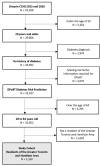Forecasting Diabetes Cases Prevented and Cost Savings Associated with Population Increases of Walking in the Greater Toronto and Hamilton Area, Canada
- PMID: 34360428
- PMCID: PMC8345977
- DOI: 10.3390/ijerph18158127
Forecasting Diabetes Cases Prevented and Cost Savings Associated with Population Increases of Walking in the Greater Toronto and Hamilton Area, Canada
Abstract
Promoting adequate levels of physical activity in the population is important for diabetes prevention. However, the scale needed to achieve tangible population benefits is unclear. We aimed to estimate the public health impact of increases in walking as a means of diabetes prevention and health care cost savings attributable to diabetes. We applied the validated Diabetes Population Risk Tool (DPoRT) to the 2015/16 Canadian Community Health Survey for adults aged 18-64, living in the Greater Toronto and Hamilton area, Ontario, Canada. DPoRT was used to generate three population-level scenarios involving increases in walking among individuals with low physical activity levels, low daily step counts and high dependency on non-active forms of travel, compared to a baseline scenario (no change in walking rates). We estimated number of diabetes cases prevented and health care costs saved in each scenario compared with the baseline. Each of the three scenarios predicted a considerable reduction in diabetes and related health care cost savings. In order of impact, the largest population benefits were predicted from targeting populations with low physical activity levels, low daily step counts, and non active transport use. Population increases of walking by 25 min each week was predicted to prevent up to 10.4 thousand diabetes cases and generate CAD 74.4 million in health care cost savings in 10 years. Diabetes reductions and cost savings were projected to be higher if increases of 150 min of walking per week could be achieved at the population-level (up to 54.3 thousand diabetes cases prevented and CAD 386.9 million in health care cost savings). Policy, programming, and community designs that achieve modest increases in population walking could translate to meaningful reductions in the diabetes burden and cost savings to the health care system.
Keywords: attributable costs; population-level; prediction model; prevention; type 2 diabetes.
Conflict of interest statement
The authors declare no conflict of interest. The funders had no role in the design of the study; in the collection, analyses, or interpretation of data; in the writing of the manuscript, or in the decision to publish the results.
Figures


Similar articles
-
The cost of diabetes in Canada over 10 years: applying attributable health care costs to a diabetes incidence prediction model.Health Promot Chronic Dis Prev Can. 2017 Feb;37(2):49-53. doi: 10.24095/hpcdp.37.2.03. Health Promot Chronic Dis Prev Can. 2017. PMID: 28273040 Free PMC article.
-
Cost-Effectiveness of the US Food and Drug Administration Added Sugar Labeling Policy for Improving Diet and Health.Circulation. 2019 Jun 4;139(23):2613-2624. doi: 10.1161/CIRCULATIONAHA.118.036751. Epub 2019 Apr 15. Circulation. 2019. PMID: 30982338 Free PMC article.
-
Effectiveness of community-wide and individual high-risk strategies to prevent diabetes: a modelling study.PLoS One. 2013;8(1):e52963. doi: 10.1371/journal.pone.0052963. Epub 2013 Jan 4. PLoS One. 2013. PMID: 23308127 Free PMC article.
-
Health and Economic Impacts of the National Menu Calorie Labeling Law in the United States: A Microsimulation Study.Circ Cardiovasc Qual Outcomes. 2020 Jun;13(6):e006313. doi: 10.1161/CIRCOUTCOMES.119.006313. Epub 2020 Jun 4. Circ Cardiovasc Qual Outcomes. 2020. PMID: 32493057 Free PMC article.
-
Repaglinide : a pharmacoeconomic review of its use in type 2 diabetes mellitus.Pharmacoeconomics. 2004;22(6):389-411. doi: 10.2165/00019053-200422060-00005. Pharmacoeconomics. 2004. PMID: 15099124 Review.
Cited by
-
Incentivised physical activity intervention promoting daily steps among university employees in the workplace through a team-based competition.Front Public Health. 2024 Jan 22;11:1121936. doi: 10.3389/fpubh.2023.1121936. eCollection 2023. Front Public Health. 2024. PMID: 38328536 Free PMC article.
-
Predictive Modelling of Diabetes Risk in Population Groups Defined by Socioeconomic and Lifestyle Factors in Canada: A Cross-Sectional Study.Int J Public Health. 2024 Aug 20;69:1607060. doi: 10.3389/ijph.2024.1607060. eCollection 2024. Int J Public Health. 2024. PMID: 39229383 Free PMC article.
References
Publication types
MeSH terms
LinkOut - more resources
Full Text Sources
Medical
Miscellaneous

